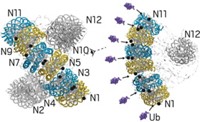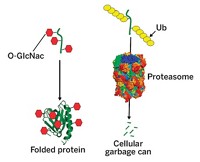Advertisement
Grab your lab coat. Let's get started
Welcome!
Welcome!
Create an account below to get 6 C&EN articles per month, receive newsletters and more - all free.
It seems this is your first time logging in online. Please enter the following information to continue.
As an ACS member you automatically get access to this site. All we need is few more details to create your reading experience.
Not you? Sign in with a different account.
Not you? Sign in with a different account.
ERROR 1
ERROR 1
ERROR 2
ERROR 2
ERROR 2
ERROR 2
ERROR 2
Password and Confirm password must match.
If you have an ACS member number, please enter it here so we can link this account to your membership. (optional)
ERROR 2
ACS values your privacy. By submitting your information, you are gaining access to C&EN and subscribing to our weekly newsletter. We use the information you provide to make your reading experience better, and we will never sell your data to third party members.
Biological Chemistry
Tau Protein, Synthetically
Protein Engineering: Researchers make, modify key player in Alzheimer’s disease
by Lauren K. Wolf
January 23, 2012
| A version of this story appeared in
Volume 90, Issue 4

Researchers in Germany have developed a method for producing a synthetic version of tau protein labeled with phosphate at a specific site. Being able to make a full version of tau—one of the main actors in Alzheimer’s disease—and to chemically modify it at a specific amino acid site should help scientists uncover more about the mechanism by which tau’s malfunction leads to disease.
Normally, tau stabilizes microtubules, which act as scaffolding inside cells such as neurons. But in Alzheimer’s, enzymes add an excessive number of phosphate groups to tau, causing it to dissociate from the microtubules and form tangled fibers inside nerve cells.
Although researchers have known about the more than 30 sites on tau that become phosphorylated, says Christian P. R. Hackenberger of the Free University of Berlin, they haven’t been able to investigate them individually or in desired combinations. That’s because conventional techniques for producing the protein and labeling it with phosphate can’t be controlled site-specifically.
Hackenberger’s group has now used expressed protein ligation to achieve the first synthesis of tau protein containing a single phosphorylated site on its C-terminus (Chem. Eur. J., DOI: 10.1002/chem.201103032). The researchers first made a 389-amino acid recombinant fragment of tau in Escherichia coli and then generated a 52-amino acid C-terminal segment with solid-phase peptide synthesis. The shorter fragment contained a phosphorylated serine at its C-terminus and a biotin tag for product purification. To put the two pieces together, the team nudged a thioester on one end of the recombinant fragment and a cysteine on one end of the synthetic segment to react and form a native peptide bond.
If this approach can be extended to phosphorylate internal sites on tau, rather than just the C-terminus, says Guy Lippens, a structural biologist at France’s National Center for Scientific Research, “it might lead to a final understanding of the relationship between the physiological and pathological aspects of tau.”
Hackenberger says it is conceivable that central regions of tau could be specifically phosphorylated with expressed protein ligation but that it is a long-term goal.





Join the conversation
Contact the reporter
Submit a Letter to the Editor for publication
Engage with us on Twitter